7.2 Review of Anatomy and Physiology of the Endocrine System
The endocrine system includes several glands, including the pineal, hypothalamus, pituitary, thyroid, parathyroid, and adrenal glands, as well as the pancreas, ovaries, and testes. See Figure 7.1 for an illustration of these organs of the endocrine system.[1]
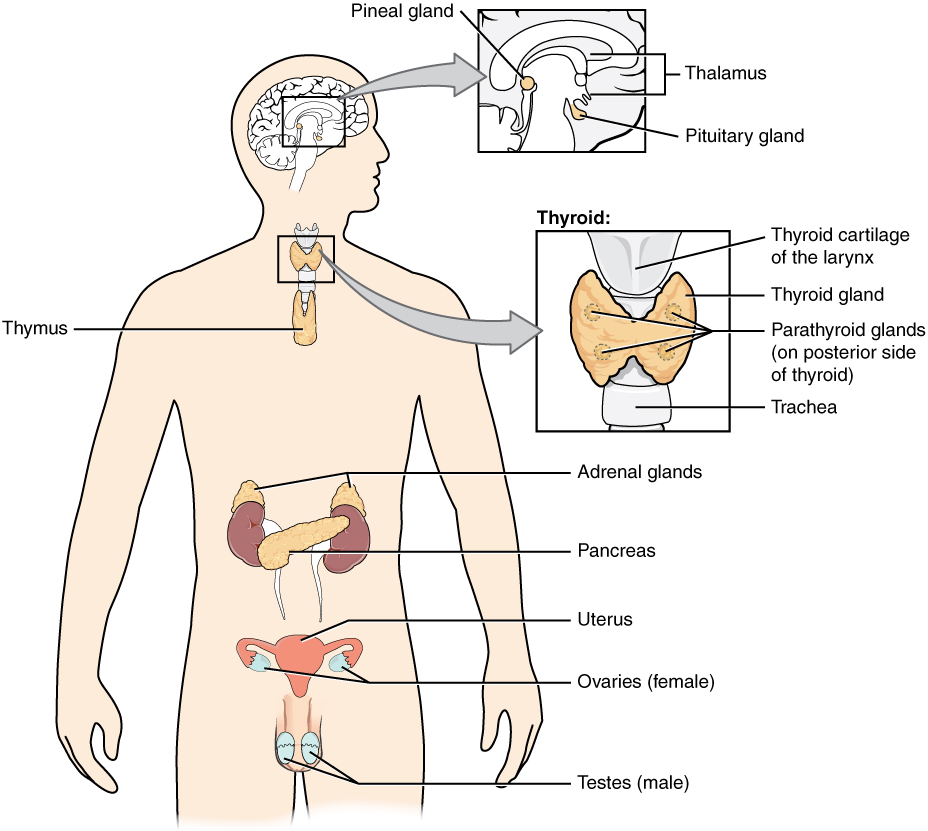
Endocrine glands secrete hormones as chemical signaling. Hormones are transported via the bloodstream throughout the body, where they bind to receptors on target cells, triggering a characteristic response. This long-distance communication is the fundamental function of the endocrine system.
Pineal Gland
The pineal gland is a small cone-shaped structure that extends posteriorly from a ventricle of the brain. The pineal gland produces the hormone melatonin and secretes it directly into the cerebrospinal fluid, which carries it into the blood. Melatonin affects reproductive development and daily circadian rhythms.[2]
Thymus Gland
The thymus gland is located in the mediastinum. It is responsible for production of T lymphocytes for the body’s immune response.
Hypothalamus and Pituitary
The hypothalamus can be viewed as the body’s control center. The hypothalamus connects to the pituitary gland by the stalk-like infundibulum. The pituitary gland is about the size of a pea and consists of an anterior and posterior lobe. Each secretes different hormones in response to signals from the hypothalamus. See Figure 7.2 for an illustration of the hypothalamus–pituitary complex.[3]
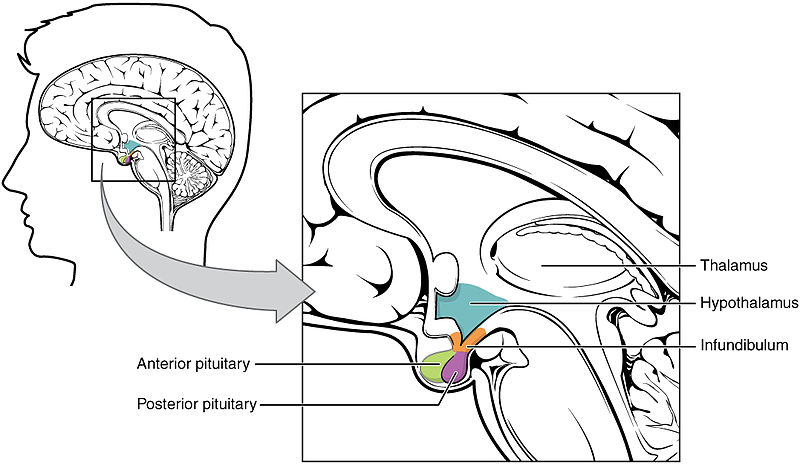
The hypothalamus–pituitary complex releases hormones that stimulate secretion of other hormones by other endocrine glands and also produce direct responses in target tissues. Its main function is to maintain a stable state called homeostasis. See Figure 7.3[4] for an illustration of the effects of the hormones released by the anterior and posterior pituitary glands.
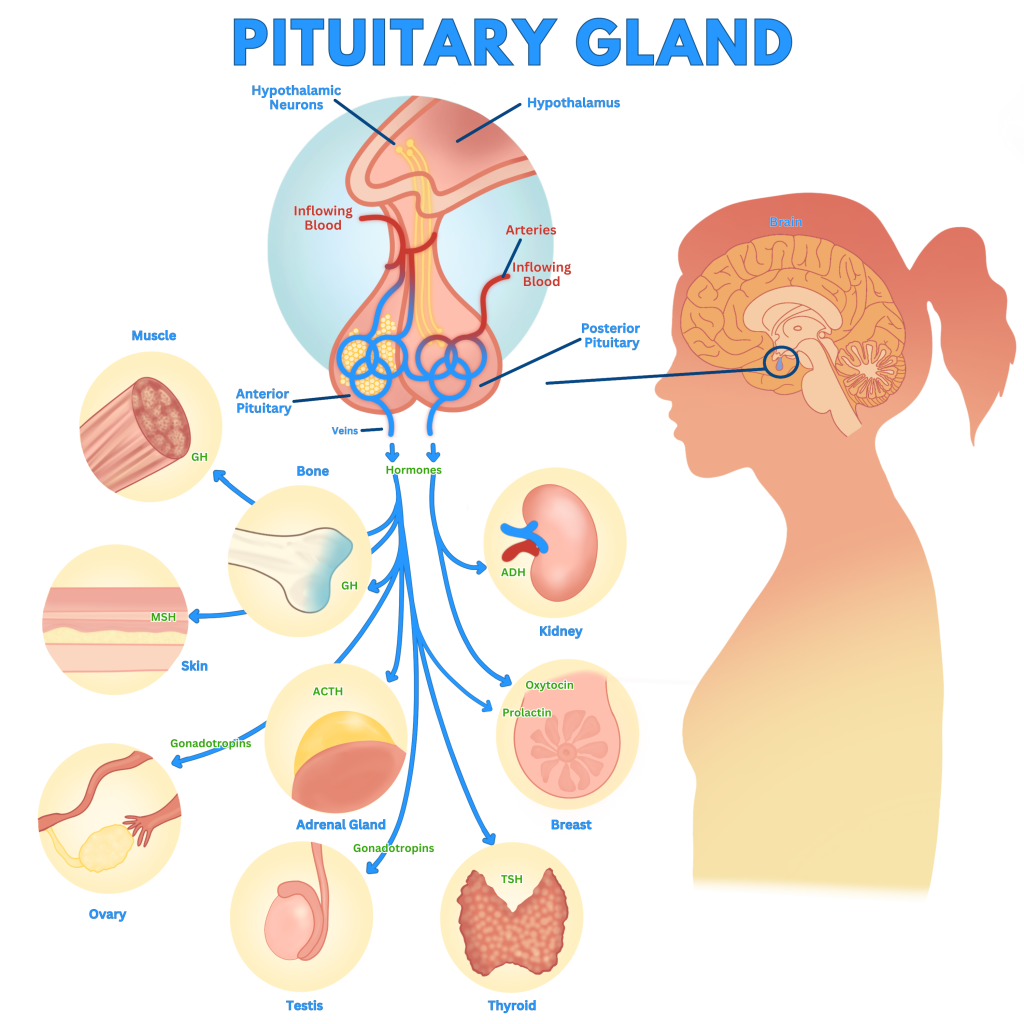
Posterior Pituitary
The posterior pituitary gland secretes two hormones produced by the hypothalamus called oxytocin and antidiuretic hormone (ADH).
- Oxytocin stimulates labor contractions and lactation after delivery.
- Antidiuretic hormone (ADH) regulates blood osmolarity by targeting the kidneys to increase water reabsorption.
Blood osmolarity refers to the concentration of sodium and other solutes in the blood. Blood osmolarity levels change in response to fluid intake, salty food ingestion, head injuries, disease, and side effects of medications. Blood osmolarity is constantly monitored by osmoreceptors in the hypothalamus.
As blood osmolarity increases beyond normal levels, the posterior pituitary is stimulated to release ADH. For example, high blood osmolarity can occur if someone eats a very salty meal or becomes dehydrated from inadequate intake of fluids. Osmoreceptors sense the high blood osmolarity and trigger the sensation of thirst, while also stimulating the posterior pituitary to release ADH. ADH targets the kidneys to increase water reabsorption. As more water is reabsorbed by the kidneys and is returned to the blood, blood osmolarity decreases.
In contrast, if blood osmolarity decreases beyond normal levels, the release of ADH is inhibited, causing the kidney to increase the elimination of water and resulting in dilute urine.
Drugs can also affect the secretion of ADH or imitate its effects. For example, alcohol consumption inhibits the release of ADH, resulting in increased dilute urine production that can eventually lead to dehydration (and a hangover). Another example is vasopressin, a synthetic ADH medication that is used to treat very low blood pressure by causing the kidneys to retain water. Vasopressin is also used to treat a disease called diabetes insipidus (DI). People with DI have decreased amounts of ADH released by their pituitary, resulting in excessive amounts of dilute urine and severe dehydration.[5]
Anterior Pituitary
The anterior pituitary produces seven hormones:
- Growth hormone (GH): Promotes growth in children, helps maintain normal body structure in adults, and plays a role in metabolism in both children and adults.
- Thyroid-stimulating hormone (TSH): Stimulates thyroid hormone release by the thyroid gland. For example, if thyroid hormone levels in the blood are too low, the pituitary gland makes larger amounts of TSH to tell the thyroid to work harder. Conversely, if thyroid hormone levels are too high, the pituitary gland releases little or no TSH.
- Adrenocorticotropic hormone (ACTH): Regulates the release of glucocorticoid hormone (cortisol) by the adrenal gland.
- Follicle-stimulating hormone (FSH): Plays a role in sexual development and reproduction by affecting the function of the ovaries and testes.
- Luteinizing hormone (LH): Plays a role in sexual development in children and in women and triggers ovulation (the release of an egg from the ovary) during the menstrual cycle.
- Beta-endorphin: Possesses morphine-like effects and plays a role in pain management and natural reward circuits such as feeding, drinking, sex, and maternal behavior.
- Prolactin: Stimulates breast development and milk production in females.
Of the hormones released by the anterior pituitary, TSH, ACTH, FSH, and LH are referred to as tropic hormones because they turn on or off the function of other endocrine glands.
Negative Feedback Loop
TSH and ACTH levels in the blood are controlled by a negative feedback loop with the hypothalamus.
Thyroid-Stimulating Hormone (TSH)
The hypothalamus stimulates the anterior pituitary with thyrotropin-releasing hormone (TRH). In response, the anterior pituitary stimulates the thyroid with thyroid-stimulating hormone (TSH). In response to TSH, the thyroid releases thyroid hormones called T3 and T4.
A negative feedback loop regulates the release of TSH by the anterior pituitary. For example, if the level of thyroid hormones (T3 and T4) decreases in the bloodstream, the hypothalamus increases the secretion of TRH. TRH causes the anterior pituitary to increase the secretion of TSH. TSH stimulates the thyroid to increase production and release of T3 and T4. For this reason, a hypofunctioning thyroid is often diagnosed by elevated TSH levels. See Figure 7.4[6] for an image of the hypothalamus-anterior pituitary-thyroid axis and the corresponding negative feedback loop.
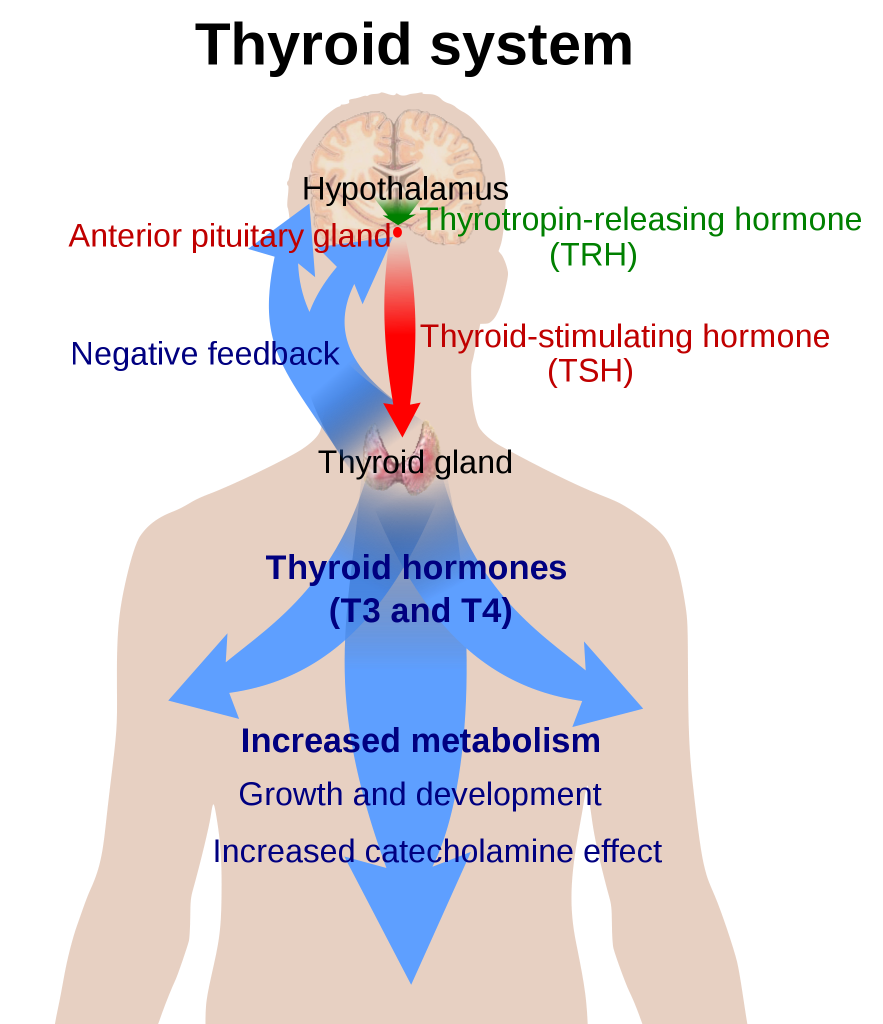
Adrenocorticotropic Hormone (ACTH)
The hypothalamus stimulates the anterior pituitary with corticotropin-releasing hormone (CRH). In response, the anterior pituitary releases adrenocorticotropic hormone (ACTH) to stimulate the adrenal cortex to release corticosteroids.[7]
A negative feedback loop regulates the release of ACTH by the anterior pituitary. For example, if levels of corticosteroids decrease in the bloodstream, the hypothalamus increases the secretion of CRH, causing the anterior pituitary to increase the secretion of ACTH. This is often referred to as the hypothalamus-pituitary-adrenal (HPA) axis. See Figure 7.5[8] for an image of the HPA axis and negative feedback loop.
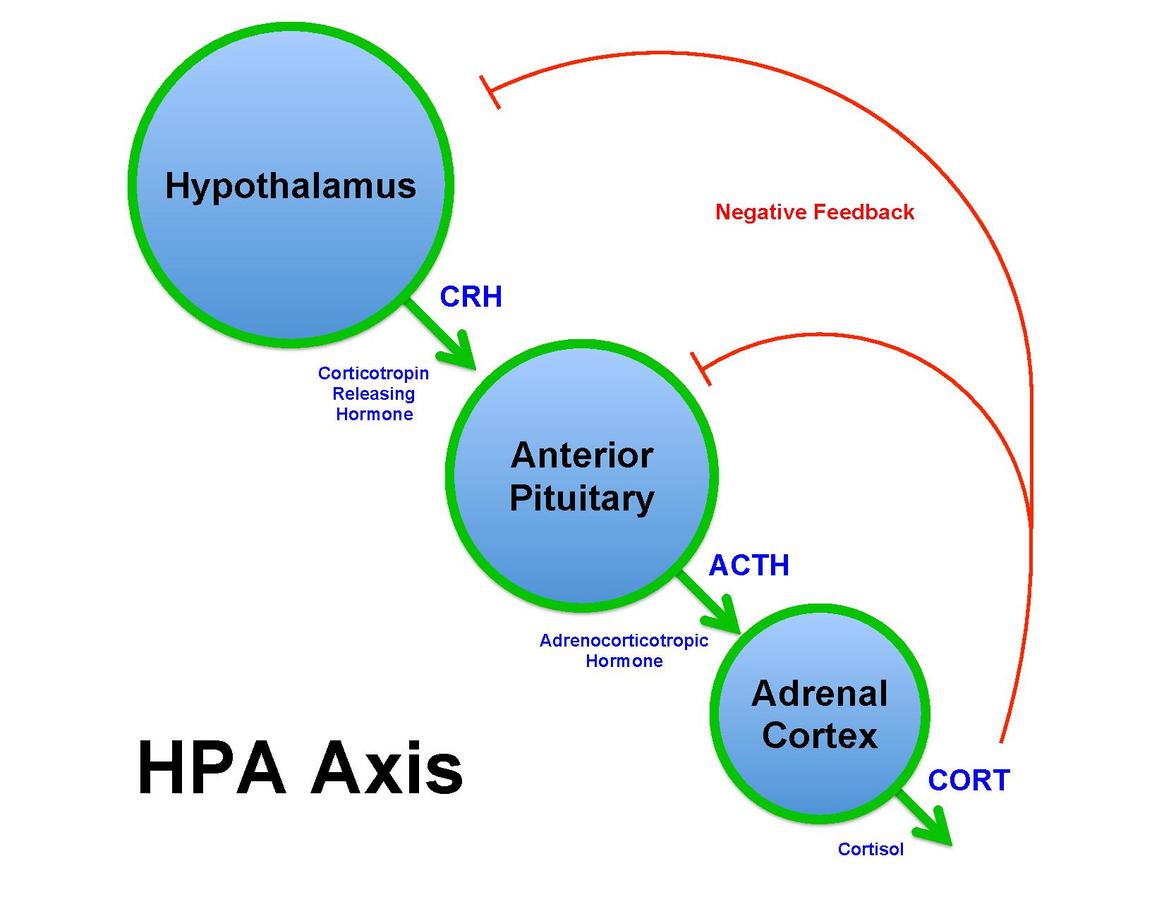
Thyroid Gland
The thyroid gland is a butterfly-shaped endocrine gland located in the neck, just below the larynx. It helps to regulate metabolic processes in the body by producing and releasing thyroid hormones.
The thyroid releases these two hormones:
- Thyroxine (T4)
- Triiodothyronine (T3)
Both T3 and T4 are iodine-containing compounds. These hormones are critical for regulating the body’s basal metabolic rate (BMR), the rate at which the body burns energy at rest.
The primary functions of thyroid hormones T3 and T4 include the following:
- Regulation of Metabolism: Control how the body uses energy and oxygen, impacting processes such as digestion, heart rate, and temperature regulation.
- Growth and Development: Impact normal growth and development, particularly in children and infants. They influence the growth of bones, as well as the development of the brain and the nervous system.
- Temperature Regulation: Regulate body temperature by controlling heat production and heat dissipation mechanisms.
- Energy Production: Involved in the conversion of food into energy. They affect the breakdown of carbohydrates, fats, and proteins for energy use.
- Heart Rate and Blood Pressure: Influence heart rate and the strength of heart contractions, helping to maintain cardiovascular function.
- Brain Function: Play a role in cognitive function, mood regulation, and mental alertness. For example, hypothyroidism (low thyroid hormone levels) can lead to cognitive and emotional changes.
The production and release of thyroid hormones are regulated by the hypothalamus-pituitary complex discussed earlier in this chapter.
Parathyroid Glands
Four small masses of tissue are embedded on the surface of the thyroid gland called parathyroid glands.
Parathyroid glands secrete parathyroid hormone (PTH). PTH maintains homeostasis between calcium and phosphorus via a negative feedback loop. Calcium and phosphorus have an inverse relationship, meaning if phosphorus levels rise, calcium levels will drop.
Adrenal Glands
The adrenal glands are small glands located on top of each kidney. There are two parts to the adrenal gland called the adrenal cortex and the adrenal medulla. Each part has distinct functions:
- Adrenal Cortex: The adrenal cortex is responsible for producing a group of steroid hormones known as corticosteroids. Corticosteroids can be further divided into three categories called mineralocorticoids, glucocorticoids, and androgens.
- Mineralocorticoids: The principal mineralocorticoid is aldosterone. Aldosterone regulates electrolyte and fluid balance in the body by controlling sodium and potassium levels in the blood. It is a key component of the renin-angiotensin-aldosterone system (RAAS) in which specialized cells of the kidneys secrete renin in response to low blood volume or low blood pressure. Renin then catalyzes angiotensinogen to the hormone Angiotensin I. Angiotensin I is converted to Angiotensin II by the angiotensin-converting enzyme (ACE). Angiotensin II stimulates the release of aldosterone. Many cardiac medications target the effects of aldosterone and the RAAS system. For example, ACE inhibitors block the production of Angiotensin II and are used to reduce high blood pressure.
- Glucocorticoids: The principal glucocorticoid is cortisol. Cortisol is the most important glucocorticoid because it plays a crucial role in metabolism, immune response, and the body’s response to stress. Cortisol helps regulate blood sugar levels, suppress inflammation, and manage the stress response.
- Androgens: These are secreted in minimal amounts in both sexes by the adrenal cortex, but their effect is usually masked by the hormones from the testes and ovaries.
- Adrenal Medulla: The adrenal medulla is responsible for producing epinephrine and norepinephrine. These hormones play a central role in the body’s “fight or flight” response to stress that is triggered by the sympathetic nervous system. Epinephrine and norepinephrine prepare the body for action by increasing heart rate, dilating airways, and redirecting blood flow to muscles, among other effects.
View a supplementary YouTube video[9] on ACTH and the adrenal gland:
Ovaries and Testes
In females, the ovaries produce ova (eggs), and in males, the testes produce sperm. Ovaries and testes also secrete hormones.
Ovaries secrete estrogen and progesterone[10]:
- At the onset of puberty, estrogen promotes the development of breasts and the maturation of the uterus.
- Progesterone causes the uterine lining to thicken in preparation for pregnancy.
- Together, progesterone and estrogen are responsible for the changes that occur in the uterus during the female menstrual cycle.
Testes secrete testosterone. At the onset of puberty, testosterone is responsible for the following actions[11]:
- The growth and development of the male reproductive structures
- Increased skeletal and muscular growth
- Enlargement of the larynx accompanied by voice changes
- Growth and distribution of body hair
Pancreas
The pancreas is a long, flat gland that lies behind the stomach. The pancreas serves two roles called exocrine and endocrine. The exocrine role refers to the release of digestive enzymes called amylase and lipase that help to digest food. The endocrine role refers to the production of glucagon and insulin by clusters of cells called islet cells to regulate blood glucose levels and keep them within a healthy range. See Figure 7.6[12] for an illustration of the pancreas.
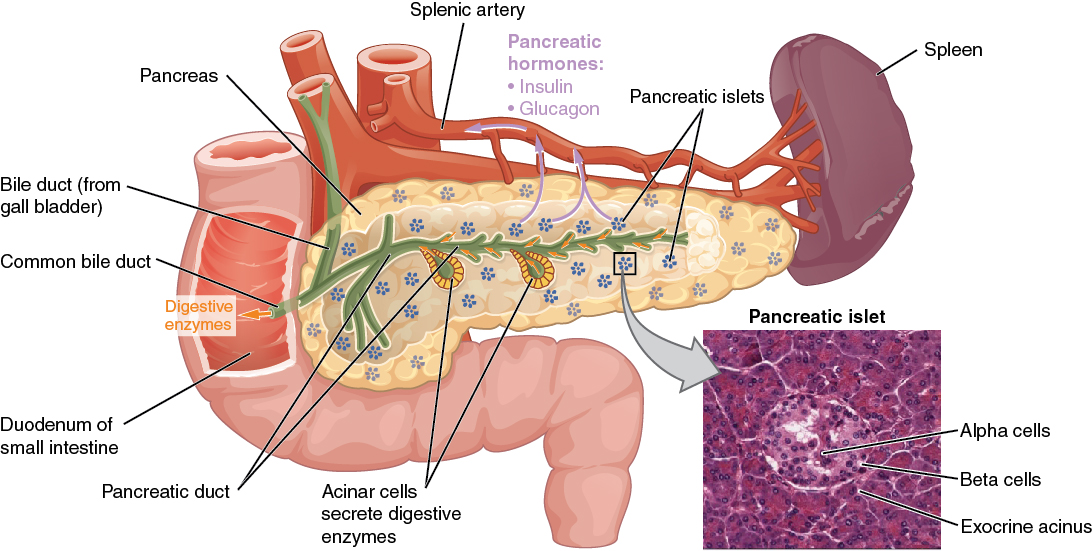
The islet cells in the pancreas include alpha, beta, and delta cells:
- Alpha Cells: Alpha cells secrete a hormone called glucagon. The primary function of glucagon is to increase blood glucose levels. When blood glucose levels drop (such as between meals or during exercise), glucagon is released.
- Beta Cells: Beta cells secrete insulin. Insulin facilitates the uptake of glucose by cells from the bloodstream, thus reducing blood glucose levels.
- Delta Cells: Delta cells secrete somatostatin. Somatostatin slows down the secretion of insulin and glucagon when needed to maintain blood glucose homeostasis.
Regulation of Blood Glucose Levels by Insulin and Glucagon
Glucose is the primary fuel for all body cells and the only fuel source for the brain. The digestive system breaks down carbohydrates into glucose, where it is absorbed into the bloodstream. Glucose is taken up by cells for fuel. Glucose that is not immediately used by cells is stored in the liver and muscles as glycogen. It is also converted into triglycerides and stored in adipose (fat) tissue.
Blood glucose levels are maintained by healthy individuals’ bodies between 70 mg/dL and 110 mg/dL. Receptors located in the pancreas sense blood glucose levels, and the islet cells secrete glucagon or insulin to maintain normal blood glucose levels. If blood glucose levels rise above this range, insulin is released, which stimulates body cells to take in glucose from the blood. If blood glucose levels drop below this range, glucagon is released, which stimulates cells to release glucose from the stored glycogen into the bloodstream.
Glucagon
When blood glucose levels drop between meals or during exercise, the alpha cells secrete glucagon, which increases blood glucose levels by stimulating the following actions:
- Within cells, it inhibits the uptake of glucose.
- It stimulates the liver to convert stored glycogen into glucose and release it into the bloodstream, a process called glycogenolysis.
- It stimulates the liver to take up amino acids from the blood and converts them into glucose, a process called gluconeogenesis.
- It stimulates the breakdown of stored triglycerides into free fatty acids and glycerol, a process called lipolysis. Glycerol travels to the liver, where it is converted into glucose. This is also a form of gluconeogenesis.
Insulin
The presence of food in the intestine triggers the beta cells in the pancreas to produce and secrete insulin. As blood glucose levels continue to rise as nutrients are absorbed into the bloodstream, insulin continues to be released and stimulates the following actions:
- It stimulates the uptake of glucose by cells by triggering the movement of glucose transporters to the cell membranes, which move glucose into the interior of cells for energy. Glycolysis is the first step in the breakdown of glucose to extract energy for cellular metabolism.
- It stimulates the liver to convert excess blood glucose into glycogen for storage. It also inhibits glycogenolysis and gluconeogenesis.
- Excess glucose is synthesized into triglycerides, a process called lipogenesis.
The secretion of insulin and glucagon by the pancreas is regulated through a negative feedback loop. As glucose levels decrease in the bloodstream, insulin release is inhibited. Conversely, as glucose levels rise in the bloodstream, glucagon release is inhibited. See Figure 7.7[13] for an illustration of the homeostatic regulation of blood glucose levels.
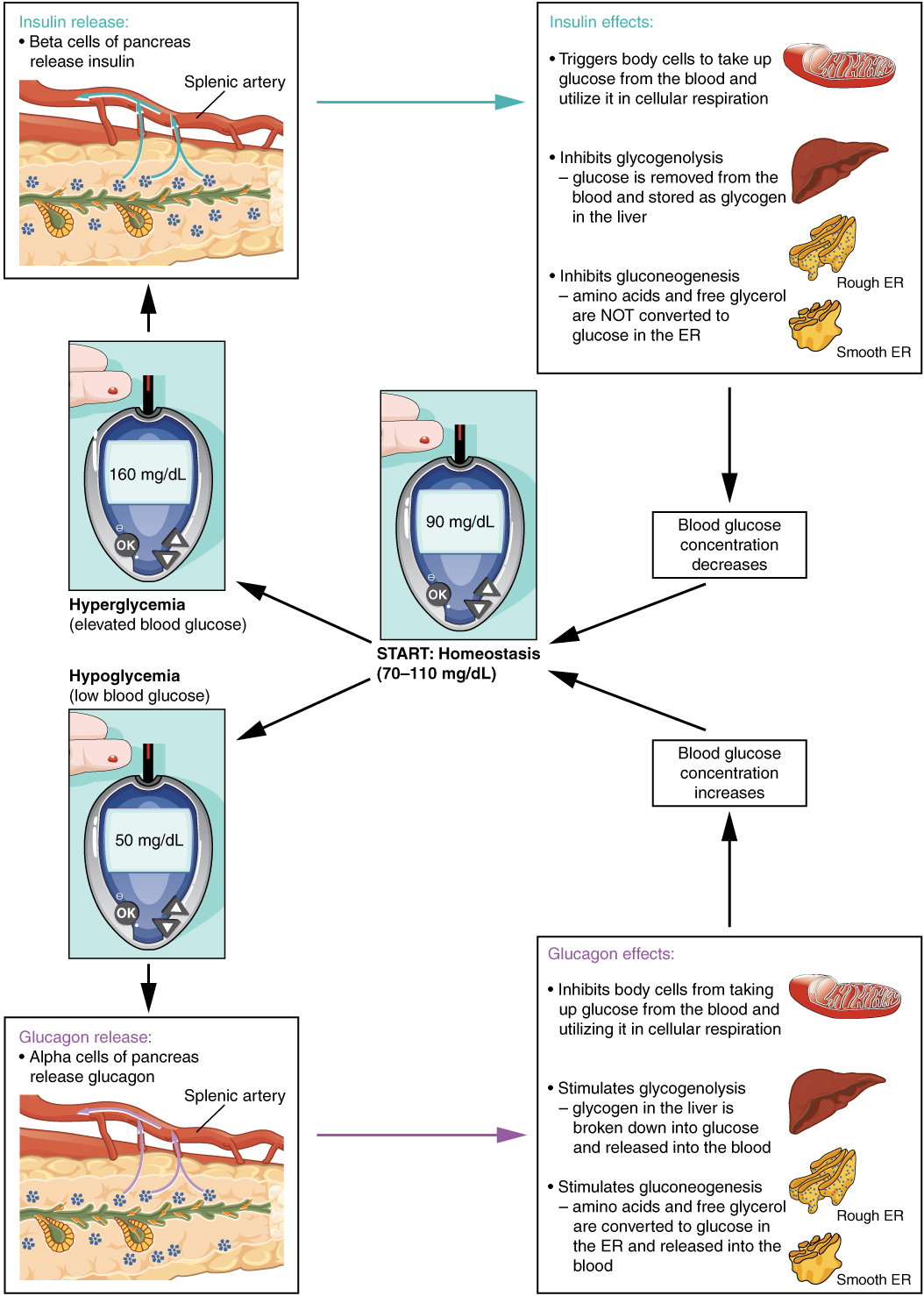
- “1801 The Endocrine System.jpg” by OpenStax is licensed under CC BY 3.0 ↵
- National Cancer Institute. (n.d.). Endocrine glands & their function. https://training.seer.cancer.gov/anatomy/endocrine/glands/ ↵
- “1806 The Hypothalamus-Pituitary Complex.jpg” by OpenStax is licensed under CC BY 3.0 ↵
- "Pituitary Gland" by Meredith Pomietlo is licensed under CC BY 4.0 ↵
- This work is a derivative of Anatomy and Physiology by OpenStax licensed under CC BY 4.0. Access for free at https://openstax.org/books/anatomy-and-physiology/pages/1-introduction ↵
- “Thyroid_system.svg” by Mikael Häggström is licensed in the Public Domain. ↵
- This work is a derivative of Anatomy and Physiology by OpenStax licensed under CC BY 4.0. Access for free at https://openstax.org/books/anatomy-and-physiology/pages/1-introduction ↵
- “Brian_M_Sweis_HPA_Axis_Diagram_2012.pdf” by BrianMSweis is licensed under CC BY-SA 3.0 ↵
- Forciea, B. (2015, May 12). Anatomy and physiology: Endocrine system: ACTH (Adrenocorticotropin hormone) V2.0 [Video]. YouTube. All rights reserved. Video reused with permission. https://youtu.be/4m7XflJzm2w. ↵
- National Cancer Institute. (n.d.). Gonads. https://training.seer.cancer.gov/anatomy/endocrine/glands/gonads.html ↵
- National Cancer Institute. (n.d.). Gonads. https://training.seer.cancer.gov/anatomy/endocrine/glands/gonads.html ↵
- “1820 The Pancreas.jpg” by OpenStax is licensed under CC BY 3.0 ↵
- “1822 The Homeostatic Regulation of Blood Glucose Levels.jpg” by OpenStax is licensed under CC BY 3.0 ↵
A regulatory chemical substance produced by specialized cells or glands in the endocrine system that helps to regulate physiological processes.
A small cone-shaped structure that extends posteriorly from a ventricle of the brain.
Hormone affecting reproductive development and circadian rhythm.
An organ found in the space between the sternum and the aorta of the heart.
Area of the brain which serves as the body’s control center regulating temperature, heart rate, hunger, and mood.
Gland located at the base of the brain which makes, stores, and releases hormones.
Coordinates the messages of the endocrine and nervous systems.
Ability to maintain a stable state.
Gland which secretes two hormones produced by the hypothalamus called oxytocin and antidiuretic hormone (ADH).
Stimulates labor contractions and lactation after delivery.
Regulates blood osmolarity by targeting the kidneys to increase water reabsorption.
The concentration of sodium and other solutes in the blood.
Receptors located in the hypothalamus that monitor blood osmolarity.
Rare medical condition characterized by excessive thirst and the excretion of large amounts of very dilute urine.
Promotes growth in children, helps maintain normal body structure in adults, and plays a role in metabolism in both children and adults.
Stimulates thyroid hormone release by the thyroid gland.
Regulates the release of glucocorticoid hormone (cortisol) by the adrenal gland.
Plays a role in sexual development and reproduction by affecting the function of the ovaries and testes.
Plays a role in sexual development in children and in women and triggers ovulation (the release of an egg from the ovary) during the menstrual cycle.
Possesses morphine-like effects and plays a role in pain management and natural reward circuits such as feeding, drinking, sex, and maternal behavior.
Stimulates breast development and milk production in females.
Turn on or off the function of other endocrine glands.
A regulatory mechanism that serves to maintain stability and homeostasis by counteracting changes in a physiological or environmental parameter.
A butterfly-shaped endocrine gland located in the neck, just below the larynx.
Four small masses of tissue are embedded on the surface of the thyroid gland.
Maintains homeostasis between calcium and phosphorus via a negative feedback loop.
Small glands located on top of each kidney.
Responsible for producing a group of steroid hormones known as corticosteroids.
Group of steroid hormones produced by the adrenal cortex; examples include mineralcorticoids, glucosteriods, and androgens.
The most important glucocorticoid because it plays a crucial role in metabolism, immune response, and the body's response to stress.
Responsible for producing epinephrine and norepinephrine.
Promotes the development of breasts and the maturation of the uterus.
Hormone that causes the uterine lining to thicken in preparation for pregnancy.
Hormone responsible for the growth and development of male reproductive structures, increased skeletal and muscular growth, enlargement of the larynx, and growth and distribution of body hair.
A long, flat gland that lies behind the stomach which is responsible for endocrine and exocrine functions.
Refers to the release of digestive enzymes called amylase and lipase that help to digest food.
Refers to the production of glucagon and insulin by clusters of cells called islet cells to regulate blood glucose levels and keep them within a healthy range.
Secrete a hormone called glucagon.
Hormone which is released in response to low blood glucose in order to raise blood glucose levels.
Secrete insulin.
Facilitates the uptake of glucose by cells from the bloodstream, thus reducing blood glucose levels.
Secrete somatostatin.
Slows down the secretion of insulin and glucagon when needed to maintain blood glucose homeostasis.
Glucose that is not immediately used by cells is stored in the liver and muscles.
A process which stimulates the liver to convert stored glycogen into glucose and release it into the bloodstream.
A process which stimulates the liver to take up amino acids from the blood and converts them into glucose.
A process which involves the breakdown of stored triglycerides into free fatty acids and glycerol.
The first step in the breakdown of glucose to extract energy for cellular metabolism.
A process in which excess glucose is synthesized into triglycerides.

